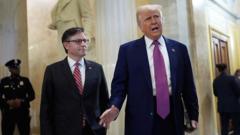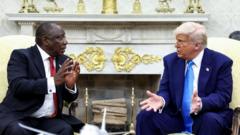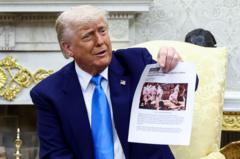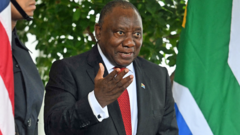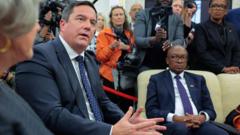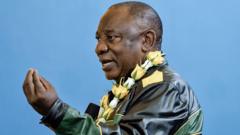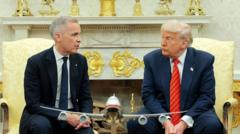Trump confronted Ramaphosa over alleged violence towards white farmers in South Africa, presenting misleading evidence during a White House meeting. Claims of genocide and misrepresented footage sparked a robust discussion about the actual circumstances.
Trump's Misleading Claims in Oval Office Showdown with South Africa's Ramaphosa

Trump's Misleading Claims in Oval Office Showdown with South Africa's Ramaphosa
During a White House meeting, Trump made baseless assertions about violence against white farmers, leading to a heated exchange with South African President Cyril Ramaphosa.
In a tense encounter at the White House, former President Donald Trump confronted South African President Cyril Ramaphosa, presenting controversial claims and misleading visual content regarding the violence against white farmers in South Africa. What began as a cordial exchange swiftly evolved into confrontation as Trump showcased a video that implied systemic violence against white farmers, accompanied by dramatic claims of genocide.
The footage, featuring rows of crosses, was misrepresented by Trump as grave sites for murdered white farmers. In reality, the crosses were placed during a protest for Glen and Vida Rafferty, a farming couple killed in 2020. Local activist Darrell Brown clarified that the crosses symbolized multiple victims over time, not individual burial sites. Further investigation into the location revealed that by May 2023, the crosses were no longer there, debunking Trump's claims effectively.
Additionally, during the exchange, Trump reiterated his claims of a "white genocide" coinciding with a high murder rate in South Africa; however, the statistics presented by the South African Police Service revealed only a handful of murders related to farmers, making the accusations unfounded. A South African judge has also dismissed claims of genocide as "not real."
Moreover, Trump highlighted footage of political rallies in which some individuals sang contentious anti-apartheid songs, suggesting they were government officials inciting violence against white farmers. However, Ramaphosa emphasized that the singers belonged to a small opposition party that does not align with government policy, contradicting Trump's narrative. The identities of the figures in the footage, like Julius Malema and former President Jacob Zuma, were noted to be from the past and not representative of current government stance.
Lastly, Trump presented articles as corroborating evidence for his assertions, including a supposed image of burial sites for farmers that turned out to be an unrelated report from the Democratic Republic of Congo. The misrepresentation of evidence calls into question the validity of claims made during a meeting that sparked national and international scrutiny.
In conclusion, despite the grave tone of Trump's accusations, the facts reflect a vastly different reality regarding violence against white farmers in South Africa. Ramaphosa's calm rebuttal served to highlight the inaccuracies in Trump's statements during the Oval Office confrontation.


